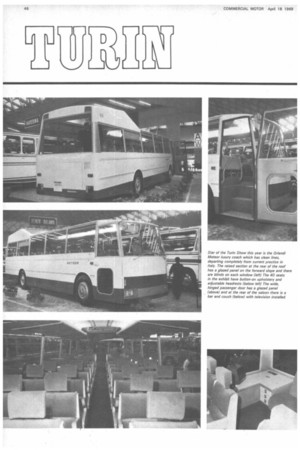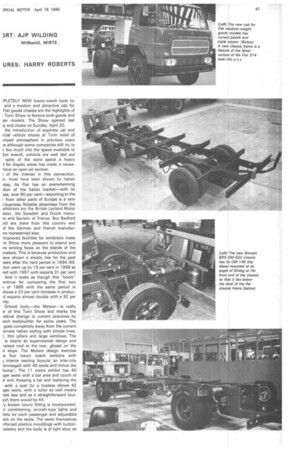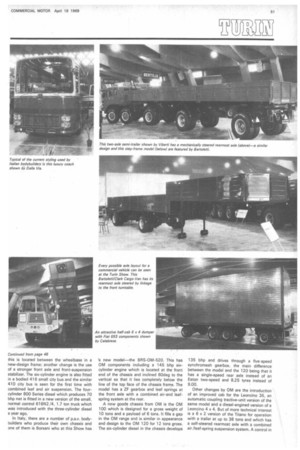_1 1_ i ov
Page 48

Page 49

Page 50

Page 54

If you've noticed an error in this article please click here to report it so we can fix it.
r
)RT: AJP WILDING
MIMechE, MIRTE IPLETELY NEW luxury-coach body by and a modern and attractive cab for Fiat goods chassis are the highlights of : Turin Show to feature both goods and ;er models. The Show opened last ly and closes on Sunday. April 20.
the introduction of separate car and rcial vehicle shows at Turin most of rnped atmosphere in previous years ie although some companies still try to a too much into the space available to But overall, exhibits are well laid out spite of the extra space a heavy I for display areas has made it neceshave an open-air section.
t of the interest in this connection, ar, must have been shown by Italian flies. As Fiat has an overwhelming lion of the Italian market—with its tea, over 90 per cent—exporting to the from other parts of Europe is a very t business. Notable absentees from the ixhibitors are the British Leyland Motor 3tion, the Swedish and Dutch manurs and Saviem of France. But Bedford )rd are there from this country and of the German and French manufacire represented also.
improved facilities for exhibitors make -in Show more pleasant to attend and ire smiling faces on the stands of the makers. This is because production and lave shown a steady rise for the past ears after the hard period in 1964 /65. tion went up by 15 per cent in 1968 as red with 1967 with exports 31 per cent And it looks as though this "boom" )ntinue for comparing the first two 5 of 1969 with the same period in ;hows a 25 per cent increase in producid exports almost double with a 92 per mp.
Orlandi body—the Meteor—is really ar of this Turin Show and marks the Tidical change to current practices by )ach bodybuilder for some years. The goes completely away from the current ornate Italian styling with simple lines, I, thin pillars and large windows. The is clearly an experimental design and raised roof at the rear, glazed on the d slope. The Meteor design exercise as four luxury coach versions with interior seating layouts; an inter-city envisaged with 49 seats and minus the hump". The 11 metre exhibit has 40 iger seats with a bar area and couch at 3 r end. Keeping a bar and replacing the with a seat for a hostess allows 42 igec seats, with a toilet as well means !ate less and as a straightforward tourach there would be 44.
-y known luxury fitting is incorporated, ir conditioning, aircraft-type lights and lets for each passenger and adjustable sts on the seats. The seats themselves nforced plastics mouldings with buttontolstery and the body is of light alloy on
a steel framework with Fiat mechanical components used on the chassis, The body has a very high-standard finish and looks as though it will be very expensive but Mr. Orlandi assured me that if the model goes into production the actual exhibit would cost no more than 20 per cent more than a comparable coach of conventional design and without the raised roof the price would be the same.
A number of changes are announced by Fiat at this Turin Show but the most important of them is the new-design cab which has an attractive appearance and high-standard interior fittings. The cab departs from the current European trend as it has curved styling but it has similarities in this respect to OM and Uric (of France) cabs—both of these concerns are in the Fiat group. The new cab is shown by Fiat on 650N2 and 662N2 trucks for 5 and 6.2 ton payload respectively—and both of these chassis have the six-cylinder 110 bhp net diesel from the new 800 range of three-. fourand six-cylinder units which use common components.
A horizontal version of the six-cylinder 800 diesel is a new feature of the Fiat 314/2 chassis for inter-city passenger operation and this is located between the wheelbase in a new-design frame; another change is the use of a stronger front axle and front-suspension stabilizer. The six-cylinder engine is also fitted in a bodied 416 small city bus and the similar 410 city bus is seen for the first time with combined leaf and air suspension. The fourcylinder 800 Series diesel which produces 70 bhp net is fitted in a new version of the small, normal control 616N2/4, 1.7 ton truck which was introduced with the three-cylinder diesel a year ago.
In Italy, there are a number of p.s.v. bodybuilders who produce their own chassis and one of them is Borsani who at this Show has 'a new model—the BRS-OM-520. This has OM components including a 145 bhp sixcylinder engine which is located at the front end of the chassis and inclined 60deg to the vertical so that it lies completely below the line of the top face of the chassis frame. The model has a ZF gearbox and leaf springs at the front axle with a combined air-and leafspring system at the rear.
A new goods chassis from OM is the OM 100 which is designed for a gross weight of 10 tons and a payload of 6 tons. It fills a gap in the OM range and is similar in appearance and design to the OM 120 for 12 tons gross. The six-cylinder diesel in the chassis develops 135 bhp and drives through a five-speed synchromesh gearbox, the main difference between the model and the 120 being that it has a single-speed rear axle instead of an Eaton two-speed and 8.25 tyres instead of 9.00.
Other changes by OM are the introduction of an improved cab for the Leoncino 35, an automatic coupling tractive-unit version of the same model and a diesel-engined version of a Leoncino 4 x 4. But of more technical interest is a 6 x 2 version of the Titano for operation with a trailer at up to 38 tons and which has a self-steered rearmost axle with a combined air/leaf-spring suspension system. A control in
































































































































